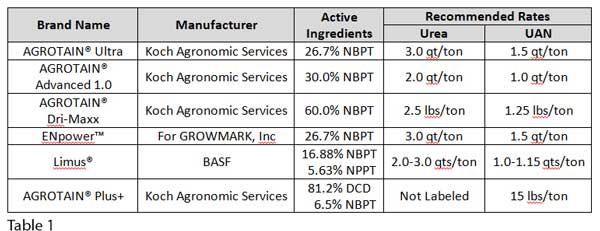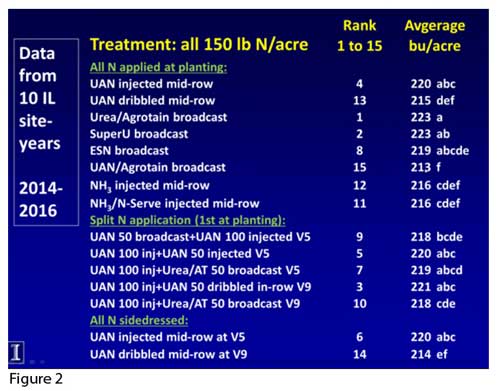- The soil enzyme urease hydrolyzes urea within only a few days of application.
- After hydrolysis, urea and urea ammonium nitrate (UAN) fertilizers are subject to nitrogen loss by volatilization of ammonia from the soil surface.
- Factors increasing volatilization risk include: lack of incorporation, less than 0.5" rainfall within 10 days of application, presence of crop residues, open crop canopies, high temperatures, humidity > 70%, windy conditions, high soil pH, and low soil CEC.
- Urease inhibitors reduce the urease enzyme activity and slow the rate of hydrolysis, stabilizing the nitrogen, preventing environmental loss, and ensuring that nitrogen will be available.
Urea Hydrolysis
Urease is a naturally-occurring extracellular enzyme that is produced by soil microbes and is found nearly everywhere in the environment, including soils, manures, and plant residues. Urease hydrolyzes urea and urea ammonium nitrate (UAN) fertilizers within a few days following application, in the reaction shown here:
(NH2)2CO + 2H2O (Urea) ---> 2NH4HCO3 (Ammonium Carbonate) ---> 2NH3 + H2O + CO2 (Ammonia Gas)
The hydrolysis of urea is a necessary step to liberate the nitrogen and make it plant available. If urea is incorporated into soil with adequate moisture, the ammonia gas will react with water to become an ammonium cation, which will become adsorbed to the cation exchange sites and retained. However, if the urea is not incorporated, the nitrogen is subject to loss by volatilization of ammonia gas from the soil surface. Nitrogen loss potential is significant. With temperatures greater than 75 degrees F, nitrogen loss can exceed 30% in the first 5 days, and may reach 55% at 15 days (see Figure 1).

Volatilization risk with surface applications is dependent upon several different factors. Ideally, a rainfall event in excess of 0.5" within the first few days after application will incorporate the urea into the soil and minimize losses. Extended dry conditions following surface application will result in much higher nitrogen losses. Losses may be higher with surface applications to moist soils that are rapidly drying and with warmer air temperatures. Volatilization losses are higher in soils with elevated pH, because a hydrogen ion gets pulled away from the ammonium cation and forces the chemical equilibrium back toward ammonia gas. No-till and reduced tillage systems with high surface residue are more prone to ammonia volatilization losses. Finally, soils with low CEC have greater losses, because of fewer change sites to retain the ammonium ions.
Urease Inhibitors
One of the most effective management tools for preventing ammonia loss from surface applications of urea or UAN is a urease inhibitor. Several active ingredients are marketed as urease inhibitors, but this article will focus on those with the most extensive scientific credibility. The most consistently demonstrated active ingredient is NBPT [N-(n-butyl) thiophosphoric acid triamide], which locks into the enzyme binding site and prevents the urease from acting upon the urea. It may also sequester nickel, which is a vital co-factor for urease activity. NBPT is sold commercially as various formulations of AGROTAIN® (Koch Agronomic Services) and also as ENpower™ (private label). Limus® (BASF) combines NBPT with a second urease inhibitor molecule known as NPPT. See Table 1 for a summary of products.
Several university research studies over the past 20 years have demonstrated the performance and yield benefits of NBPT. For a comprehensive review of the scientific findings on NBPT and other urease inhibitors, please see the references below. NBPT decreases the rate of ammonia volatilization of surface-applied urea by 50-90% for up to 10 days following application, depending on conditions. A long-term study in Illinois showed an 11-bu yield advantage in no-till corn for surface-applied urea+AGROTAIN® vs untreated urea. The same study showed a 3-bu yield advantage with urea+AGROTAIN® versus untreated urea in conventional till, even when the products were incorporated following broadcast application. Urea+AGROTAIN® pre-plant was the statistically best nitrogen management approach among all the various forms and timings studied in a 3-year research trial recently completed in Illinois (See Figure 2 from Nafziger, 2017). The bottom line is that NBPT works as advertised and can buy risk protection against nitrogen loss from surface applied urea or UAN for up to 10 days, until a timely rain can incorporate the nitrogen.
Combination products are also available with both a urease inhibitor and a nitrification inhibitor to protect against three modes of loss: volatilization, denitrification, and leaching. The two commercially available combination products are AGROTAIN®Plus and Super U®, both of which contain NBPT and dicyandiamide (DCD). AGROTAIN® Plus is specifically formulated for application to UAN or manure. Super U® is a pre-treated manufactured urea fertilizer.
Summary of Management Recommendations
- Immediately incorporate urea and direct-inject UAN to minimize volatilization losses.
- Consider a urease inhibitor for extra protection, even when urea fertilizers are incorporated.
- ALWAYS use a urease inhibitor with surface-applied urea or UAN, especially in high-residue systems and post-emergent applications.
- Dribble UAN in a concentrated band instead of broadcast application.
- Consider combination stabilizer products that include a urease inhibitor and a nitrification inhibitor, especially when all nitrogen is applied pre-plant and in environments that favor denitrification or leaching losses.
Contact your FS Crop Specialist for your agronomic needs.


Figure 1. Chart showing cumulative nitrogen loss as ammonia volatilization from urea with and without a urease inhibitor in a Dewitt silt loam soil incubated at 77 degrees F (derived from Franzen et al, 2011).
Table 1. Selected commercial urease inhibitor products.
Figure 2. Summary data slide from 3-year nitrogen trial in Illinois (Webinar by Nafziger, 2017)